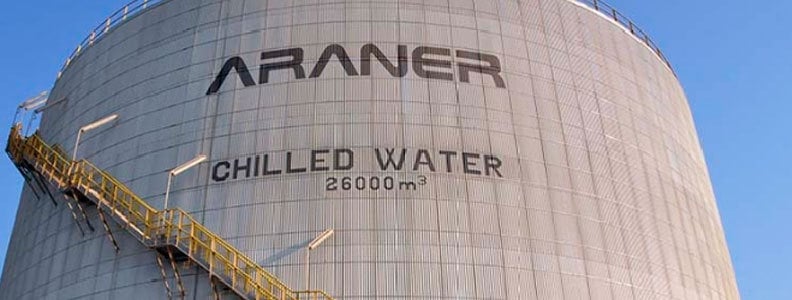Office and commercial buildings have the largest percentage (about 70%) of their annual energy demand going into covering air conditioning load. These facilities happen to operate mostly during the day so they add to the daytime peak demand. Compared to the daily average load, the peak demand can be extremely high. Interestingly, this peak demand tends to happen during a specific period of the day. Utilities have no choice but to meet this demand, meaning that substantial capacity can remain unused for most of the time. Utility companies may be forced to build new power plants, just to meet this peak demand. That is unless they have built a TES tank technology, which is the most sophisticated and budget-conscious technology for space cooling/Heating. That’s not the only area where TES tanks come in handy- natural gas power plants, military facilities and data centers are other candidates. So much that goes into designing the best TES tank, but today we will focus on the ideal TES tank material.
Customer Requirement Matters
As we have mentioned, ARANER TES tanks are necessary when energy demand varies immensely. For instance, district energy plants experience such scenarios between night and day average demands. Our TES tanks are also applicable for Turbine Inlet Air Cooling (TIAC) to support peak demand. Our TES tanks are designed to offer reduced operational and capital cost. ARANER designs and installs state-of-the-art TES tanks. We use the most appropriate construction materials for each case, with big consideration of the storage medium. Customers have different requirements, but most of these fall within the suitability of major TES tank materials. Two of our most popular materials are steel and concrete. Use of any of these depends on the specific requirements of the customer. Apart from these materials being sturdy and environmentally friendly, clients are pleased that they can extend, relocate or dismantle the units relatively easily. With appreciation of different design preferences, we are capable of delivering TES tanks covered or open. In all this, we never divert from the main goal, which is to help the customer realize the best outcome in energy efficiency and power augmentation.
Steel TES Tank Material
Steel TES tanks form part of the ARANER’s thermal storage turnkey solutions. These reservoirs can be custom designed complete with diffuser systems for application in combined heat and power (CHP), data centers, and university campuses etc.

Fig 1: Steel TES Tank from ARANER
Steel thermal storage tanks are popular for their low initial cost. Application of advanced welding techniques and adherence to international construction standards is the key to prevention of leaks. With ARANER’s TES tank, you can be sure to have your thermal energy storage needs sorted for a wide range of applications. Cylindrical pressurized versions have a capacity range of between 3,000 and 56,000 gallons. There are a few challenges with steel thermal storage tanks though, even when the handler is an experienced thermal storage contractor. For instance, they can only be used aboveground because they are susceptible to humidity damage. Maintenance costs remain relatively high. This reminds of API 653, which is a set of guidelines developed by the American Petroleum Institute (API) for inspection, repair, alteration, and reconstruction of aboveground steel tanks in America and other entities. With the availability of polyurethane coatings for both interior and exterior of the tank, corrosion issues are more manageable nowadays. Such developments continue to promote the popularity of steel tanks, especially for smaller systems.
Concrete TES Tank
Another option is concrete thermal storage tank. This solution is most popular for underground or partial underground facilities. One of the biggest advantages of this method is the flexibility, which is enough to adapt the shape to the requirements of the space. Concrete TES tank offers one of the most economical reservoir solutions because the costs for construction and maintenance are manageable. In most cases, the maintenance requirements are nil. Construction materials are often locally available and the methods are suitable. Even better is the fact that concrete tanks are relatively immune to mechanical impact. Even dangerous substances may not have any impact on this tank. To crown everything, this material is suitable for holding a wide range of substances, including extremely cool water and hot water up to 100ºC. When it reaches to temperatures higher than 100ºC, a deep pressure study has to be taken. With only a special linear, these reservoirs have been used to store liquefied gases at low temperatures. Clients have two choices when it comes to concrete thermal storage tank: Cast in-situ and precast/pre-stressed. In-situ construction refers to the process of constructing the entire TES tank in its final location by application of ground-mounted formwork. This is different from precast product, which has its own benefits. For instance, it provides a higher compressive strength that is necessary for buried tanks. In summary, these are the benefits of concrete thermal TES tanks:
- No tainting of water by plastic by metal products
- Working life normally exceeds that of metal
- Capacities usually large
- Concrete uses environmentally friendly materials
- Can be buried underground
- For underground versions, visual impact on property is minimized
Are you planning to install a TES tank?
When you know the performance requirements of a TES tank, it becomes easier to choose the ideal tank material. Steel and concrete have unique characteristics, which come with both merits and demerits. We insist on a feasible analysis of these options depending on client needs such as space and load profile. That is how thermal storage EPCs get to choose the ideal TES tank material.










